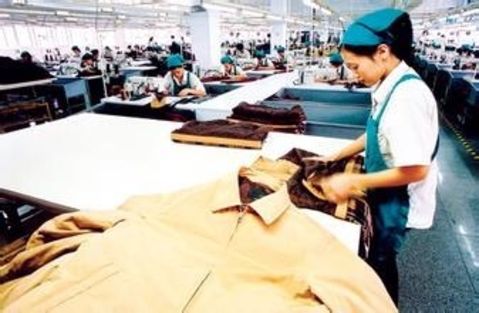After the Chinese economy entered a new normal, the economic growth rate slowed down gradually, and the income of residents was expected to be lowered. At the same time, under the impact of e-commerce channels and foreign brands, the choice of consumers expanded, consumer behavior became more rational, and pursuit of higher cost performance. Products, fast fashion brands led by ZARA are accelerating expansion. The opportunity of the garment industry under the new normal of China's economy Today, Fast Fashion accelerates the deployment of second- and third-tier cities and continues to strengthen its leading position and competitiveness in the market. The industry predicts that in the future, fast fashion will expand its product line in China faster and faster. At the same time, with the evolution of consumer entities and the development of network technology, consumer demand is more diversified, and differentiated preferences can highlight individualized products. More and more fast fashion brands and Internet brands have shifted their focus to grasping the trend of fashion, and the demand for single-volume flexible production has become more apparent. On the other hand, the net red economy has been concerned by people and has become an important development trend in the new economy. Network Reds have become an effective channel for e-commerce diversion with the help of “weak relationship and strong influenceâ€. As far as the current situation is concerned, in order to realize the reconstruction of traditional industries and consumption patterns and establish a new economic development model, the net red economy is a new idea. Objectively, although the demand for consumer entities has changed and the Internet traffic has grown rapidly, the fast fashion and online red e-commerce companies have grown rapidly in recent years and attracted the attention of the capital market, but solved behind the scenery. The “how to produce†supply chain end, meet the individualized needs of consumers stimulated by the new operating model, and put forward the requirements of “flexible single quantity, multi-variety, quick turning†for the supply chain, which is the organizational model of the traditional supply chain of clothing. A new topic has been proposed. The flexible transformation of the clothing industry supply chain is imminent Under the new trend of the clothing industry, the traditional supply chain has been difficult to meet the new market demand. The three major clothing consumption problems of “fashionâ€, “low price†and “quality†have caused more and more industry veterans to think about the traditional supply chain. Many of the shortcomings have also made the flexibility of the supply chain more important. Relevant experts believe that whether it is clothing manufacturers or clothing brands in the market competition, playing an industry chain war. Zhao Yingguang, founder of Handu Yishe: “The development of brand e-commerce will inevitably increase the demand for the supply chain. That is to hope that everyone has the characteristics of the Internet, embrace the era of the Internet industry, and transform the supply chain from rigid to flexible to achieve upgrades. revolution." The founder of the flexible supply chain in Sinbad: “The flexible optimization of the supply chain is very important for the reduction of the operating costs of the business. The rapid production of flexible orders is an inevitable demand of clothing e-commerce. This model enables merchants to avoid backlog of large inventory. It is conducive to improving the capital turnover rate. Merchants can choose to sell products that meet the needs of users through trial sales, and create hot-selling products. At the same time, flexible replenishment can greatly reduce the business risks of merchants." As early as 2012, Sinbad began to focus on the flexible transformation of the apparel supply chain. Some of Sinbad's clients are clothing brands with flexible OEM requirements offline, and the other is millions of clothing e-commerce online. As the first team to improve the supply chain of upgraded garments, Sinbad has always been at the forefront of the industry. This is inseparable from the principle that Sinbad adheres to the principle of creating customer value and truly solving the real needs of customers. In order to tap the real pain points of the industry, the founding team of Sinbad has contacted many brand customers in the apparel industry. In the communication with them, they learned the voices of the clothing sellers: in the economic downturn in China, the entire apparel industry, especially the low end. The supply chain, for many years, is in the big environment of “bad money drives out good moneyâ€. China’s hundreds of millions of textile and garment workers are full of powerlessness and frustration. Clothing sellers face the supply chain and are helpless. They only have two choices, buy the spot or place their own orders. Buying a spot will face the risk of “out of stock, low qualityâ€, and the production of orders will face the risk of “the big factory does not accept small orders, the quality of small factories is unstable or the delivery is not timelyâ€. In this industry context, the founding team of Sinbad decided to use the “platform†model to leverage its experience in the supply chain to truly help apparel brands. The platform model integrates some conscious and powerful small and medium-sized quality garment manufacturers under the traditional Chinese line, manages them with a set of rules and methods, and releases these production capacity to most current and future through platform means. Clothing e-commerce, serving the production of large and personalized custom clothing for the present and future. Only in this way will the opportunity to let the entire clothing market bloom, in order to make the brand business live better, this is the prototype of the final idea of ​​Sinbad. Cloud-net-end mode platform upgrades apparel flexible supply chain to supply network After a long process of continuous exploration of the flexible supply chain, Sinbad has enriched and improved its business model, upgrading the flexible supply chain to a supply network, and connecting and precipitating data on national production capacity through Internet technology: factory distribution, good at category, The technical level can be digitized and programmed. Through these data, we can grasp the status of the national factory in real time and accurately match the order. Organize regional production capacity and efficient collaboration through Internet products to increase production efficiency and reduce cost waste. The core logic of the Sinbad flexible supply chain platform has three parts: cloud level, network level and end level. Cloud level: "data + algorithm" builds the core. Sinbad has modeled all orders and capacity data in the cloud for real-time control by company personnel and external customers. The core of the docking "order model" and "capacity model" is the algorithm. The system automatically generates the scheduling algorithm according to the scale, quality and delivery requirements of the order model, and pairs with the most matching workshop to generate the production plan. Network level: three role-based business networks. Including: brand customers (currently 200 online/lower brands), supply chain expert groups (composed of experienced purchasing and documentary personnel), production service centers (by 500 workshops, more than 10,000 craftsmen, cutting centers) , quality control and park logistics constitute). End level: to achieve billing, order and production schedule management. The workshop realizes orders and grabs orders through the end, the supply chain experts update the production progress through the end, the customer passes the order to place orders and master the production progress. In addition to the software side, the hardware side will be introduced in the future, such as Internet sewing machines and intelligent cutting, so as to grasp more real dynamic capacity. Therefore, in the whole system, a classic business scenario can be summarized as follows: a clothing seller orders through the client, the system breaks it into individual business modules after receiving the order, and the system allocates several to the capacity network through an algorithm. The workshop, and the production service center for fabric procurement/quality monitoring and logistics distribution, and the manual coordination in the whole process is the responsibility of the supply chain experts in the park. Under the new normal of China's economy, the clothing industry is struggling, whether it is the retail end of the clothing brand or the clothing manufacturing end, all of which are racking their brains to solve the two ultimate consumers' demands: quality and speed. The final test of these two points is the viability of the entire clothing supply chain in this increasingly flexible market. The importance of “flexibilityâ€, “low price†and “quality†to the apparel supply chain is self-evident. Sinbad's flexible supply chain platform rationally through the "cloud-net-end" model to create a clothing win-win network, starting with the supply chain upgrade, fundamentally subverting the traditional clothing manufacturing industry, not only to meet the flexible needs of e-commerce companies, Quality assurance and speed advantages have also promoted the rapid upgrade of the apparel industry from B2C to C2B, thus helping more people realize their brand dreams! Editor in charge: Kebang Fine Meshes Pvc Leather,Sofa Seat Decoration Leather,Soft Leather Pvc Leather,Anti-Aging Pvc Leather Shaoxing Weirui Import And Export Co.,Ltd , https://www.weiruileather.com


Sinbad: Traditional clothing manufacturing upgrades, starting from the supply chain